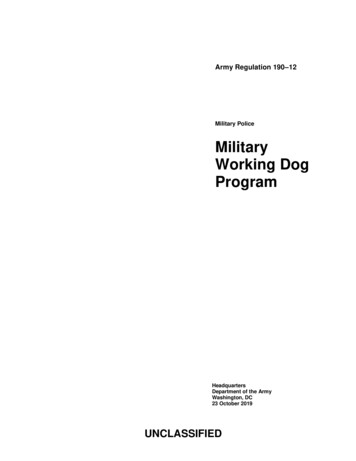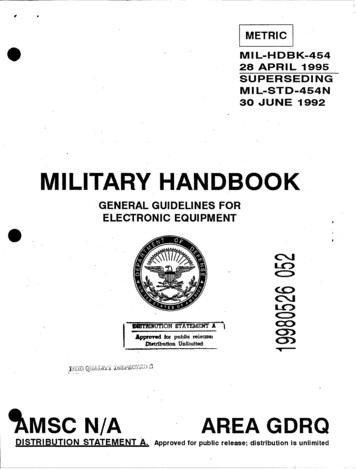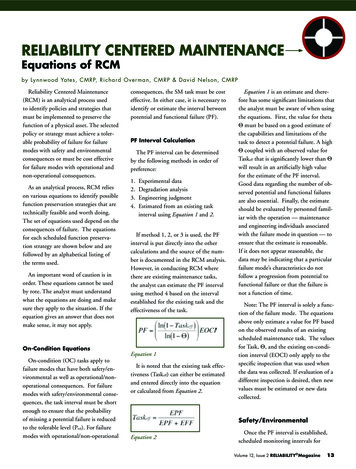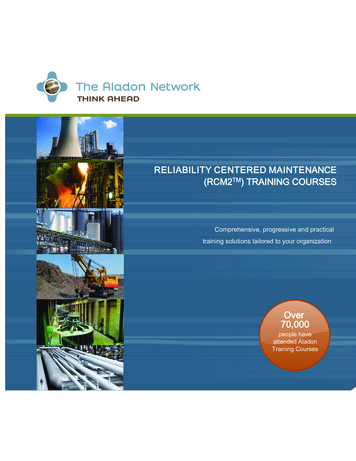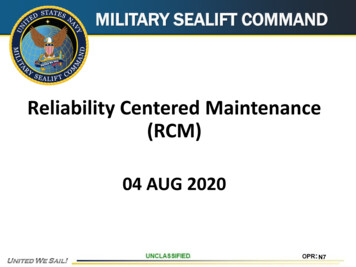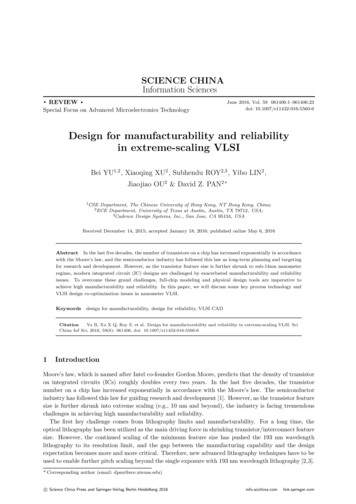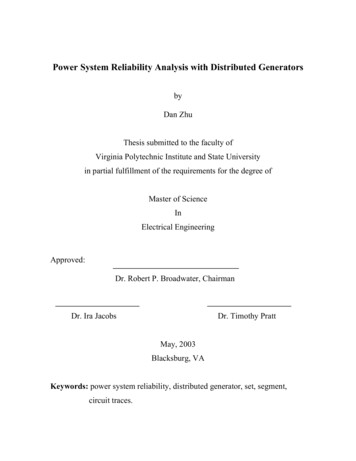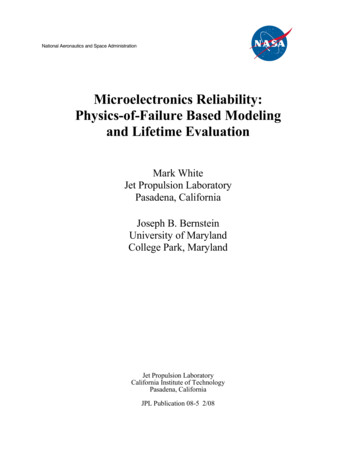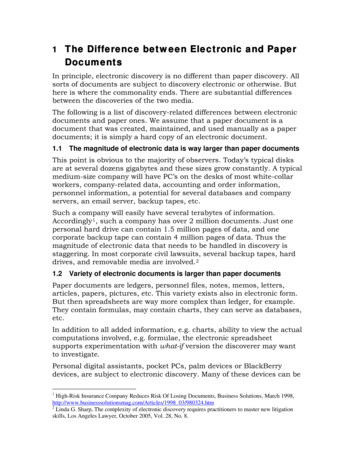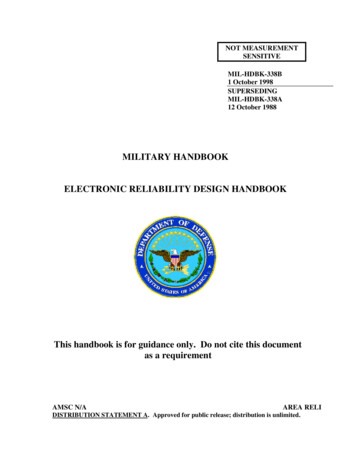
Transcription
NOT MEASUREMENTSENSITIVEMIL-HDBK-338B1 October 1998SUPERSEDINGMIL-HDBK-338A12 October 1988MILITARY HANDBOOKELECTRONIC RELIABILITY DESIGN HANDBOOKThis handbook is for guidance only. Do not cite this documentas a requirementAMSC N/AAREA RELIDISTRIBUTION STATEMENT A. Approved for public release; distribution is unlimited.
MIL-HDBK-338BFOREWORDFOREWORD1.This handbook is approved for use by all Departments and Agencies of theDepartment of Defense (DoD). It was developed by the DoD with the assistance ofthe military departments, federal agencies, and industry and replaces in its entiretyMIL-HDBK-338A. The handbook is written for reliability managers and engineersand provides guidance in developing and implementing a sound reliability programfor all types of products.2.This Handbook is for guidance only. This Handbook cannot be cited as arequirement. If it is, the contractor does not have to comply.3.Reliability is a discipline that continues to increase in importance as systemsbecome more complex, support costs increase, and defense budgets decrease.Reliability has been a recognized performance factor for at least 50 years. DuringWorld War II, the V-1 missile team, led by Dr. Wernher von Braun, developedwhat was probably the first reliability model. The model was based on a theoryadvanced by Eric Pieruschka that if the probability of survival of an element is 1/x,then the probability that a set of n identical elements will survive is (1/x)n . Theformula derived from this theory is sometimes called Lusser’s law (Robert Lusser isconsidered a pioneer of reliability) but is more frequently known as the formula forthe reliability of a series system: Rs R1 x R2 x . . x Rn.4.Despite the long gestation period for reliability, achieving the high levels needed inmilitary systems is too often an elusive goal. System complexity, competingperformance requirements, the rush to incorporate promising but immaturetechnologies, and the pressures of acquisition budget and schedule contribute to thiselusiveness. In the commercial sector, high levels of reliability are also necessary.Recently, American products once shunned in favor of foreign alternatives havemade or are making a comeback. This shift in consumer preferences is directlyattributable to significant improvements in the reliability and quality of theAmerican products.5.Noting these improvements, and facing a shrinking defense budget, the Departmentof Defense began the process of changing its acquisition policies to buy morecommercial off-the-shelf products and to use commercial specifications andstandards. The objective is to capitalize on the “best practices” that Americanbusiness has developed or adopted, primarily in response to foreign competitivepressures. When combined with the knowledge and expertise of militarycontractors in building complex and effective military systems (soundlydemonstrated during the conflict with Iraq), it is hoped that these commercialpractices will allow the Department of Defense to acquire world-class systems ontime and within budget.i
MIL-HDBK-338BFOREWORD6.The information in this Handbook reflects the move within the military toincorporate best commercial practices and the lessons learned over many years ofacquiring weapon systems “by the book”. Military as well as commercial standardsand handbooks are cited for reference because they are familiar to both military andcommercial companies. Many of the military documents are being rescinded, socopies may be difficult to obtain. For those who have copies or can obtain them,the military documents provide a wealth of valuable information.7.Beneficial comments (recommendations, additions, deletions) and any pertinentdata which may be useful in improving this document should be addressed to: AirForce Research Laboratory/IFTB, 525 Brooks Road, Rome, NY 13441-4505.Comments should be submitted using the self-addressed Standardization DocumentImprovement Proposal (DD Form 1426) appearing at the end of this document orby letter.ii
MIL-HDBK-338BTABLE OF CONTENTSTABLE OF tion.1.3Organization.2 .02.1Page1-11-11-11-12.2REFERENCED DOCUMENTS.Government Documents .2.1.1Specifications, Standards and Handbooks .Other Referenced Documents.2-12-12-12-33.03.13.23.3DEFINITIONS OF TERMS AND ACRONYMS AND ABBREVIATIONS.Introduction .Definitions .List of Abbreviations and Acronyms.3-13-13-13-214.04.14.2GENERAL STATEMENTS .Introduction and Background .The System Engineering Process .4.2.1Systems Engineering and IPTs .4.2.2The Four Steps of Systems Engineering .System Effectiveness .4.3.1R/M Considerations in System Effectiveness .Factors Influencing System Effectiveness .4.4.1Equipment of New Design .4.4.2Interrelationships Among Various System Properties .Optimization of System Effectiveness NTAINABILITY/AVAILABILITY THEORY .Introduction .Reliability Theory .5.2.1Basic Concepts .Statistical Distributions Used in Reliability Models .5.3.1Continuous Distributions .5.3.1.1 Normal (or Gaussian) Distribution .5.3.2Examples of Reliability Calculations Using the Normal Distribution.5.3.2.1 Microwave Tube Example .5.3.2.2 Mechanical Equipment Example .5.3.3Lognormal Distribution .5.3.3.1 Fatigue Failure Example 55 .05.15.25.3iii
MIL-HDBK-338BTABLE OF CONTENTSTABLE OF CONTENTSSection5.3.45.45.55.65.7ivExponential Distribution .5.3.4.1 Airborne Fire Control System Example .5.3.4.2 Computer Example .5.3.5Gamma Distribution .5.3.5.1 Missile System Example .5.3.6Weibull Distribution .5.3.6.1 Example of Use of Weibull Distribution .5.3.7Discrete Distributions .5.3.7.1 Binomial Distribution .5.3.7.1.1 Quality Control Example .5.3.7.1.2 Reliability Example .5.3.8Poisson Distribution .5.3.8.1 Example With Permissible Number of Failures .Failure Modeling .5.4.1Typical Failure Rate Curve .5.4.2Reliability Modeling of Simple Structures .5.4.2.1 Series Configuration .5.4.2.2 Parallel Configuration .5.4.2.3 K-Out-Of-N Configuration .Bayesian Statistics in Reliability Analysis .5.5.1Bayes’ Theorem .5.5.1.1 Bayes’ Example (Discrete Distribution) .5.5.1.2 Bayes’ Example (Continuous Distribution) .Maintainability Theory .5.6.1Basic Concepts .5.6.2Statistical Distributions Used in Maintainability Models .5.6.2.1 Lognormal Distribution .5.6.2.1.1 Ground Electronic System MaintainabilityAnalysis Example .5.6.2.2 Normal Distribution .5.6.2.2.1 Equipment Example .5.6.2.3 Exponential Distribution .5.6.2.3.1 Computer Example .5.6.2.4 Exponential Approximation .Availability Theory .5.7.1Basic Concepts .5.7.2Availability Modeling (Markov Process Approach) .5.7.2.1 Single Unit Availability Analysis(Markov Process Approach) -75
MIL-HDBK-338BTABLE OF CONTENTSTABLE OF CONTENTSSection5.8R&M Trade-Off Techniques .5.8.1Reliability vs Maintainability.5.9References For Section 5 .6 .06.16.26.36.4RELIABILITY SPECIFICATION, ALLOCATION, MODELING ANDPREDICTION .Introduction .Reliability Specification .6.2.1Methods of Specifying the Reliability Requirement.6.2.2Description of Environment and/or Use Conditions .6.2.3Time Measure or Mission Profile .6.2.4Clear Definition of Failure .6.2.5Description of Method(s) for Reliability Demonstration .Reliability Apportionment/Allocation .6.3.1Introduction .6.3.2Equal Apportionment Technique .6.3.3ARINC Apportionment Technique (Ref. [6]) .6.3.4Feasibility-Of-Objectives Technique (Ref. [7]) .6.3.5Minimization of Effort Algorithm .Reliability Modeling and Prediction .6.4.1Introduction .6.4.2General Procedure .6.4.2.1 Item Definition .6.4.2.2 Service Use Profile .6.4.2.3 Reliability Block Diagrams .6.4.2.4 Mathematical/Simulation Models .6.4.2.5 Part Description .6.4.2.6 Environmental Data .6.4.2.7 Stress Analysis .6.4.2.8 Failure Distributions .6.4.2.9 Failure Rates .6.4.2.10 Item Reliability .6.4.3Tailoring Reliability Models and Predictions .6.4.4Reliability Modeling .6.4.4.1 Reliability Block Diagrams .6.4.4.2 Reliability Modeling Methods .6.4.4.2.1 Conventional Probability Modeling Method .6.4.4.2.1.1 Series Model .6.4.4.2.1.2 Parallel Models .6.4.4.2.1.3 Series-Parallel Models .6.4.4.2.2 Boolean Truth Table Modeling Method 3v
MIL-HDBK-338BTABLE OF CONTENTSTABLE OF CONTENTSSection6.56.67.07.17.2vi6.4.4.2.3 Logic Diagram Modeling Method .6.4.4.2.4 Complex System Modeling Methods .6.4.4.2.4.1 Markov Modeling (Ref. [9]) .6.4.4.2.4.2 Monte Carlo Simulation Method .6.4.5Reliability Prediction .6.4.5.1 General .6.4.5.2 Mathematical Models for Reliability Prediction .6.4.5.3 Reliability Prediction Methods .6.4.5.3.1 Similar Item Prediction Method .6.4.5.3.2 Parts Count Prediction Method .6.4.5.3.3 Parts Stress Analysis Prediction Method .6.4.5.3.3.1 Stress Analysis Techniques .6.4.5.3.3.2 Sample Calculation .6.4.5.3.3.3 Modification for Non-Exponential FailureDensities (General Case) .6.4.5.3.3.4 Nonoperating Failure Rates .6.4.5.3.4 Reliability Physics Analysis (Ref. [17] and [18]) .6.4.5.4 Computer Aided Reliability Prediction .Step-By-Step Procedure for Performing Reliability Prediction and Allocation .References for Section 6 .RELIABILITY ENGINEERING DESIGN GUIDELINES .Introduction .Parts Management .7.2.1Establishing a Preferred Parts List (PPL) .7.2.2Vendor and Device Selection .7.2.2.1 Critical Devices/Technology/Vendors .7.2.2.1.1 ASIC Devices .7.2.2.1.2 GaAs and MMIC Devices .7.2.2.2 Plastic Encapsulated Microcircuits (PEMs) .7.2.2.3 Hidden Hybrids .7.2.2.4 Device Specifications .7.2.2.5 Screening .7.2.2.6 Part Obsolescence and Diminishing ManufacturerSources (DMS) .7.2.2.7 Failure Reporting, Analysis, And Corrective ActionSystem (FRACAS) .7.2.3Design for Reliability .7.2.3.1 Electronic Part Reliability Assessment / Life Analysis .7.2.4Design for Manufacturability -97-97-107-107-117-127-127-157-157-167-19
MIL-HDBK-338BTABLE OF CONTENTSTABLE OF CONTENTSSection7.2.57.37.47.5Parts Management Plan Evaluation Criteria .7.2.5.1 Quality Improvement Program .7.2.5.2 Quality Assurance .7.2.5.2.1 Part Qualification .7.2.5.2.2 Production Quality Assurance .7.2.5.3 Assembly Processes .7.2.5.4 Design Criteria .Derating .7.3.1Electronic Part Derating .7.3.2Derating of Mechanical and Structural Components .Reliable Circuit Design .7.4.1Transient and Overstress Protection .7.4.1.1 On-Chip Protection Networks .7.4.1.2 Metal Oxide Varistors (MOVs) .7.4.1.3 Protective Diodes .7.4.1.4 Silicon Controlled Rectifier Protection .7.4.1.5 Passive Component Protection .7.4.1.6 Protective Devices Summary .7.4.1.7 Protection Design For Parts, Assemblies and Equipment .7.4.1.8 Printed Wiring Board Layout .7.4.1.9 Shielding .7.4.1.10 Grounding .7.4.1.11 Protection With MOVs .7.4.1.12 Protection With Diodes .7.4.2Parameter Degradation and Circuit Tolerance Analysis .7.4.3Computer Aided Circuit Analysis .7.4.3.1 Advantages of Computer Aided Circuit Analysis/Simulation .7.4.3.2 Limitations of Computer-Aided Circuit Analysis/SimulationPrograms .7.4.3.3 The Personal Computer (PC) as a Circuit Analysis Tool .7.4.4Fundamental Design Limitations .7.4.4.1 The Voltage Gain Limitation .7.4.4.2 Current Gain Limitation Considerations .7.4.4.3 Thermal Factors .Fault Tolerant Design .7.5.1Redundancy Techniques .7.5.1.1 Impact on Testability .7.5.2Reliability Role in the Fault Tolerant Design Process .7.5.2.1 Fault Tolerant Design Analysis -847-86vii
MIL-HDBK-338BTABLE OF CONTENTSTABLE OF CONTENTSSection7.5.37.67.7viiiRedundancy as a Design Technique .7.5.3.1 Levels of Redundancy .7.5.3.2 Probability Notation for Redundancy Computations .7.5.3.3 Redundancy Combinations .7.5.4Redundancy in Time Dependent Situations .7.5.5Redundancy Considerations in Design .7.5.5.1 Partial Redundancy .7.5.5.2 Operating Standby Redundancy .7.5.5.2.1 Two Parallel Elements .7.5.5.2.2 Three Parallel Elements .7.5.5.2.3 Voting Redundancy .7.5.5.3 Inactive Standby Redundancy .7.5.5.4 Dependent Failure Probabilities .7.5.5.5 Optimum Allocation of Redundancy .7.5.6Reliability Analysis Using Markov Modeling .7.5.6.1 Introduction .7.5.6.2 Markov Theory .7.5.6.3 Development of the Markov Model Equation .7.5.6.4 Markov Model Reduction Techniques .7.5.6.5 Application of Coverage to Markov Modeling .7.5.6.6 Markov Conclusions .Environmental Design .7.6.1Environmental Strength .7.6.2Designing for the Environment .7.6.3Temperature Protection .7.6.4Shock and Vibration Protection .7.6.5Moisture Protection .7.6.6Sand and Dust Protection .7.6.7Explosion Proofing .7.6.8Electromagnetic Radiation Protection .7.6.9Nuclear Radiation .7.6.10 Avionics Integrity Program (AVIP) .7.6.10.1 MIL-STD-1670: Environmental Criteria and Guidelinesfor Air Launched Weapons .Human Performance Reliability .7.7.1Introduction .7.7.2Reliability, Maintainability, and Availability Parameters forHuman - Machine Systems .7.7.3Allocating System Reliability to Human Elements .7.7.3.1Qualitative Allocation .7.7.3.2Quantitative Allocation -1497-1517-1537-1597-1597-1617-1657-1657-167
MIL-HDBK-338BTABLE OF CONTENTSTABLE OF CONTENTSSection7.7.47.7.57.87.97.107.11Sources of Human Performance Reliability Data .Tools for Designing Man-Machine Systems .7.7.5.1 Task Analysis .7.7.5.2 General Design Tools .7.7.5.3Computer-Based Design Tools .7.7.5.3.1 Parametric Design Tools .7.7.5.3.2 Interface Design Tools .7.7.5.3.3 Work Space Design Tools .7.7.6Reliability Prediction for Human-Machine Systems .7.7.6.1 Probability Compounding .7.7.6.2 Stochastic Models .7.7.6.3 Digital Simulation .7.7.6.4 Expert Judgment Techniques .7.7.7Verification of Human Performance Reliability .Failure Mode and Effects Analysis (FMEA) .7.8.1Introduction .7.8.2Phase 1 .7.8.3Phase 2 .7.8.4Example .7.8.5Risk Priority Number .7.8.5.1 Instituting Corrective Action .7.8.6Computer Aided FMEA .7.8.7FMEA Summary .Fault Tree Analysis .7.9.1Discussions of FTA Methods .Sneak Circuit Analysis (SCA) .7.10.1 Definition of Sneak Circuit .7.10.2 SCA: Definition and Traditional Techniques .7.10.3 New SCA Techniques .7.10.4 Examples of Categories of SNEAK Circuits .7.10.5 SCA Methodology .7.10.5.1 Network Tree Production .
acquiring weapon systems “by the book”. Military as well as commercial standards and handbooks are cited for reference because they are familiar to both military and commercial companies. Many of the military documents are being rescinded, so copies may be difficult
